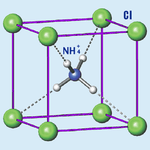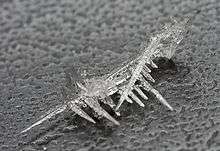Ammonium chloride
 | |
 | |
| Names | |
|---|---|
| IUPAC name
Ammonium chloride | |
| Other names
Sal ammoniac, Salmiac, Nushadir salt, Sal armagnac, Salt armoniack | |
| Identifiers | |
| 12125-02-9 | |
| 3D model (Jmol) | Interactive image |
| ChEBI | CHEBI:31206 |
| ChemSpider | 23807 |
| ECHA InfoCard | 100.031.976 |
| EC Number | 235-186-4 |
| KEGG | D01139 |
| RTECS number | BP4550000 |
| UNII | 01Q9PC255D |
| |
| |
| Properties | |
| ClH4N | |
| Molar mass | 53.49 g·mol−1 |
| Appearance | White solid, hygroscopic |
| Odor | Odorless |
| Density | 1.5274 g/cm3[1] |
| Melting point | 338 °C (640 °F; 611 K) decomposes, sublimes |
| Boiling point | 520 °C (968 °F; 793 K) |
| Sublimes at 337.6 °C[2] ΔsublH | |
| 244 g/L (−15 °C) 294 g/L (0 °C) 383.0 g/L (25 °C) 454.4 g/L (40 °C) 740.8 g/L (100 °C)[4] | |
| Solubility product (Ksp) |
30.9 (395 g/L)[5] |
| Solubility | Soluble in liquid ammonia, hydrazine, alcohol, methanol, glycerol Slightly soluble in acetone Insoluble in diethyl ether, ethyl acetate[2] |
| Solubility in methanol | 3.2 g/100 g (17 °C) 3.35 g/100 g (19 °C) 3.54 g/100 g (25 °C)[2] |
| Solubility in ethanol | 6 g/L (19 °C)[1] |
| Solubility in glycerol | 97 g/kg[2] |
| Solubility in sulfur dioxide | 0.09 g/kg (0 °C) 0.031 g/kg (25 °C)[2] |
| Solubility in acetic acid | 0.67 g/kg (16.6 °C)[2] |
| Vapor pressure | 133.3 Pa (160.4 °C)[6] 6.5 kPa (250 °C) 33.5 kPa (300 °C)[1] |
| Acidity (pKa) | 9.24 |
| Refractive index (nD) |
1.642 (20 °C)[2] |
| Thermochemistry | |
| 84.1 J/mol·K[1] | |
| Std molar entropy (S |
94.56 J/mol·K[1] |
| Std enthalpy of formation (ΔfH |
−314.43 kJ/mol[1] |
| Gibbs free energy (ΔfG˚) |
−202.97 kJ/mol[1] |
| Pharmacology | |
| B05XA04 (WHO) G04BA01 (WHO) | |
| Hazards | |
| Safety data sheet | ICSC 1051 |
| GHS pictograms |  [6] [6] |
| GHS signal word | Warning |
| H302, H319[6] | |
| P305+351+338[6] | |
| EU classification (DSD) |
|
| R-phrases | R22, R36 |
| S-phrases | (S2), S22 |
| NFPA 704 | |
| Flash point | Non-flammable |
| Lethal dose or concentration (LD, LC): | |
| LD50 (median dose) |
1650 mg/kg (rats, oral) |
| US health exposure limits (NIOSH): | |
| PEL (Permissible) |
none[7] |
| REL (Recommended) |
TWA 10 mg/m3 ST 20 mg/m3 (as fume)[7] |
| IDLH (Immediate danger) |
N.D.[7] |
| Related compounds | |
| Other anions |
Ammonium fluoride Ammonium bromide Ammonium iodide |
| Other cations |
Sodium chloride Potassium chloride Hydroxylammonium chloride |
| Except where otherwise noted, data are given for materials in their standard state (at 25 °C [77 °F], 100 kPa). | |
| | |
| Infobox references | |
Ammonium chloride is an inorganic compound with the formula NH4Cl and a white crystalline salt that is highly soluble in water. Solutions of ammonium chloride are mildly acidic. Sal ammoniac is a name of the natural, mineralogical form of ammonium chloride. The mineral is commonly formed on burning coal dumps from condensation of coal-derived gases. It is also found around some types of volcanic vents. It is mainly used as fertilizer and a flavouring agent in some types of liquorice. It is the product from the reaction of hydrochloric acid and ammonia.
Production

It is a product of the Solvay process used to produce sodium carbonate:[3]
- CO2 + 2 NH3 + 2 NaCl + H2O → 2 NH4Cl + Na2CO3
In addition to being the principal method for the manufacture of ammonium chloride, that method is used to minimize ammonia release in some industrial operations.
Ammonium chloride is prepared commercially by combining ammonia (NH3) with either hydrogen chloride (gas) or hydrochloric acid (water solution):[3]
- NH3 + HCl → NH4Cl
Ammonium chloride occurs naturally in volcanic regions, forming on volcanic rocks near fume-releasing vents (fumaroles). The crystals deposit directly from the gaseous state and tend to be short-lived, as they dissolve easily in water.[8]
Reactions
Ammonium chloride appears to sublime upon heating but actually decomposes into ammonia and hydrogen chloride gas.[3]
- NH4Cl → NH3 + HCl
Ammonium chloride reacts with a strong base, like sodium hydroxide, to release ammonia gas:
- NH4Cl + NaOH → NH3 + NaCl + H2O
Similarly, ammonium chloride also reacts with alkali metal carbonates at elevated temperatures, giving ammonia and alkali metal chloride:
- 2 NH4Cl + Na2CO3 → 2 NaCl + CO2 + H2O + 2 NH3
A 5% by weight solution of ammonium chloride in water has a pH in the range 4.6 to 6.0.[9]
Some of ammonium chloride's reactions with other chemicals are endothermic like its reaction with barium hydroxide and its dissolving in water.
Applications

The main application of ammonium chloride is as a nitrogen source in fertilizers (corresponding to 90% of the world production of ammonium chloride) such as chloroammonium phosphate. The main crops are rice and wheat in Asia.[10]
Ammonium chloride was used in pyrotechnics in the 18th century but was superseded by safer and less hygroscopic chemicals. Its purpose was to provide a chlorine donor to enhance the green and blue colours from copper ions in the flame.
It had a secondary use to provide white smoke, but its ready double decomposition reaction with potassium chlorate producing the highly unstable ammonium chlorate made its use very suspect.[11][12][13]
Metalwork
Ammonium chloride is used as a flux in preparing metals to be tin coated, galvanized or soldered. It works as a flux by cleaning the surface of workpieces by reacting with the metal oxides at the surface to form a volatile metal chloride. For that purpose, it is sold in blocks at hardware stores for use in cleaning the tip of a soldering iron, and it can also be included in solder as flux.
Medicine
Ammonium chloride is used as an expectorant in cough medicine. Its expectorant action is caused by irritative action on the bronchial mucosa, which causes the production of excess respiratory tract fluid, which presumably is easier to cough up. Ammonium salts are an irritant to the gastric mucosa and may induce nausea and vomiting.
Ammonium chloride is used as a systemic acidifying agent in treatment of severe metabolic alkalosis, in oral acid loading test to diagnose distal renal tubular acidosis, to maintain the urine at an acid pH in the treatment of some urinary-tract disorders.
Food
In several countries, ammonium chloride, under the name sal ammoniac or colloquially salmiak is used as food additive under the E number E510, commonly as a yeast nutrient in breadmaking. It is a feed supplement for cattle and an ingredient in nutritive media for yeasts and many microorganisms.
Ammonium chloride is used to spice up dark sweets called salty liquorice (very popular in Nordic countries), in baking to give cookies a very crisp texture, and in the liquor Salmiakki Koskenkorva for flavouring. In India and Pakistan, it is called "Noshader" and is used to improve the crispness of snacks such as samosas and jalebi.
In the laboratory
Ammonium chloride is used to produce low temperatures in cooling baths.[14] Ammonium chloride solutions with ammonia are used as buffer solutions including ACK (Ammonium-Chloride-Potassium) lysis buffer.[15]
In paleontology, ammonium chloride vapor is deposited on fossils, where the substance forms a brilliant white, easily removed and fairly harmless and inert layer of tiny crystals. That covers up any coloration the fossil may have, and if lighted at an angle highly enhances contrast in photographic documentation of three-dimensional specimens. The same technique is applied in archaeology to eliminate reflection on glass and similar specimens for photography.
Flotation
Giant squid and some other large squid species maintain neutral buoyancy in seawater through an ammonium chloride solution which is found throughout their bodies and is less dense than seawater. This differs from the method of flotation used by most fish, which involves a gas-filled swim bladder. The solution tastes somewhat like salmiakki and makes giant squid unattractive for general human consumption.
Other applications
Ammonium chloride is used in a ~5% aqueous solution to work on oil wells with clay swelling problems. It is also used as electrolyte in zinc–carbon batteries. Other uses include in hair shampoo, in the glue that bonds plywood, and in cleaning products. In hair shampoo, it is used as a thickening agent in ammonium-based surfactant systems such as ammonium lauryl sulfate. Ammonium chloride is used in the textile and leather industry, in dyeing, tanning, textile printing and cotton clustering. Around the turn of the 20th Century, Ammonium Chloride was used in aqueous solution as the electrolyte in Leclanche Cells. These cells found a commercial use as the "local battery" in subscribers' telephone installations.
References
- 1 2 3 4 5 6 7 Pradyot, Patnaik (2003). Handbook of Inorganic Chemicals. The McGraw-Hill Companies, Inc. ISBN 0-07-049439-8.
- 1 2 3 4 5 6 7 http://chemister.ru/Database/properties-en.php?dbid=1&id=371
- 1 2 3 4 Wiberg, Egon; Wiberg, Nils (2001). Inorganic Chemistry (illustrated ed.). Academic Press. p. 614. ISBN 0-12-352651-5.
- ↑ Seidell, Atherton; Linke, William F. (1919). Solubilities of Inorganic and Organic Compounds (2nd ed.). D. Van Nostrand Company.
Results here are multiplied by water's density at temperature of solution for unit conversion. - ↑ "Solubility Products of Selected Compounds". Salt Lake Metals. Retrieved 2014-06-11.
- 1 2 3 4 Sigma-Aldrich Co., Ammonium chloride. Retrieved on 2014-06-11.
- 1 2 3 "NIOSH Pocket Guide to Chemical Hazards #0029". National Institute for Occupational Safety and Health (NIOSH).
- ↑ Rowley, Steven P. (2011). General Chemistry I Laboratory Manual (Second ed.). Kendall Hunt. ISBN 978-0-7575-8942-3.
- ↑ Dr. K. G. Bothara (7 October 2008). Inorganic Pharmaceutical Chemistry. Pragati Books Pvt. Ltd. pp. 13–. ISBN 978-81-85790-05-3. Retrieved 12 October 2011.
- ↑ Karl-Heinz Zapp "Ammonium Compounds" in Ullmann's Encyclopedia of Industrial Chemistry 2012, Wiley-VCH, Weinheim. doi:10.1002/14356007.a02_243
- ↑ John A. Conkling; Christopher J. Mocella (2010). Chemistry of Pyrotechnics (2nd ed.). CRC Press. ISBN 978-1574447408.
- ↑ Tenney L Davis (2012). Chemistry of Powder and Explosives. Angriff Press. ISBN 978-0945001171.
- ↑ K. L. Kosanke; B. J. Kosanke; Barry T. Sturman; Robert M. Winokur (2012). Encyclopedic Dictionary of Pyrotechnics (and Related Subjects). Journal of Pyrotechnics. ISBN 978-1889526195.
- ↑ "A New Frigorifick Experiment Shewing, How a Considerable Degree of Cold May be Suddenly Produced without the Help of Snow, Ice, Haile, Wind, or Niter, and That at Any Time of the Year" (PDF). Philosophical Transactions. 1: 255–261. 18 July 1666.
- ↑ http://cshprotocols.cshlp.org/content/2014/11/pdb.rec083295.short
External links
| Wikimedia Commons has media related to Ammonium chloride. |
- Calculators: surface tensions, and densities, molarities and molalities of aqueous ammonium chloride
- CDC - NIOSH Pocket Guide to Chemical Hazards
